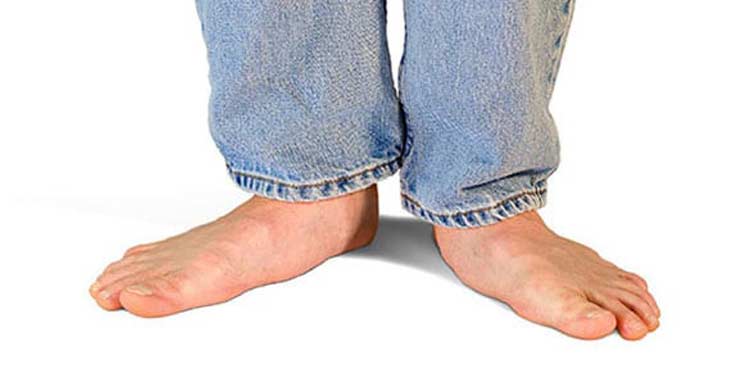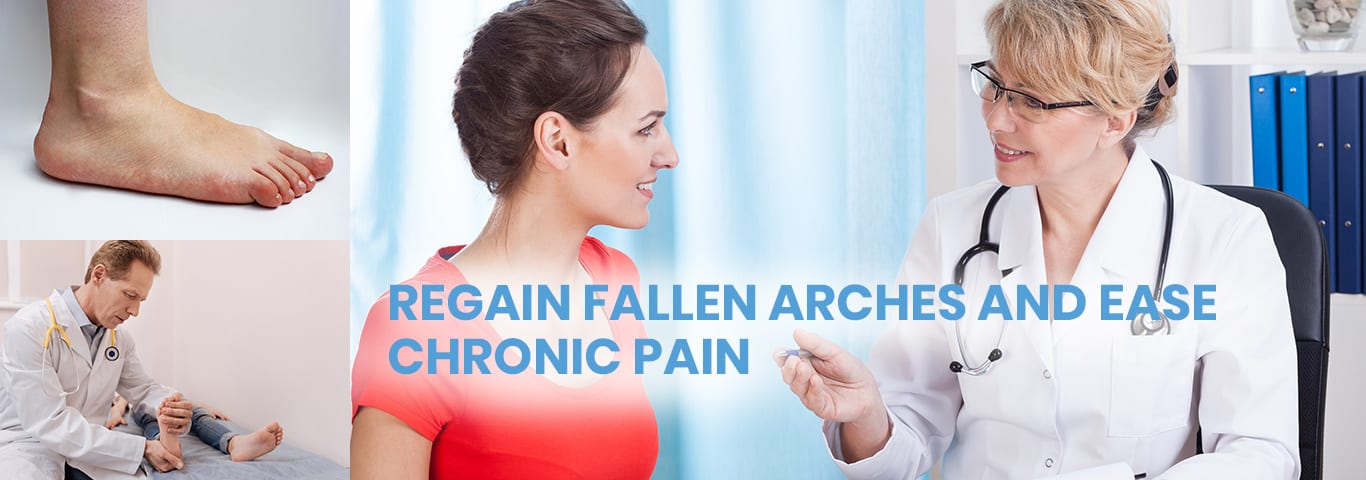
Discover how we can help you find relief from flat feet.
Flat feet, or fallen arches of pes planus, is a condition that occurs when a foot’s natural arch collapses. It’s a common condition that affects more than 3 million people in the United States. While arches may be collapsed at birth or fall during childhood due to growth-related issues, flat feet sometimes develop because of injury or the natural age-related wear and tear of tissues.
- Some people have the condition with little or no discomfort, and others have chronic foot pain because of a lack of arch support.
- Treatment will depend on the level of discomfort experienced.
Flat Feet Test and Diagnosis
A simple test called the wet test can be done to tell if you have flat feet. Get your feet wet first. Then walk on flat surface such as dry concrete or a large sheet of paper. If you see a complete imprint from your wet feet, you likely have fallen arches. A foot and ankle surgeon will be needed for a complete diagnosis.
A podiatrist can usually identify fallen arches from a visible examination. Specific tests may be done to confirm or rule out related issues with feet. For instance, an X-ray is useful for detecting arthritis. A CT or MRI scan may be performed to get a closer look at the soft tissues of the foot and ankle, especially if a related foot problem is suspected.


Causes and Contributing Factors
Flat feet in children (pediatric flatfoot) may be caused by a congenital (present at birth) deformity. Children often outgrow fallen arches as the body continues to grow and develop. In both adults and children, the condition may result in partial or completely fallen arches. Insufficient arch support sometimes contributes to related problems with ankles and knees as well as alignment of the legs. Broken or deformed bones in the foot or ankle, torn or stretched foot tendons, and inflammation or irritation of the posterior tibial tendon may also affect arches. Underlying nerve conditions and health issues like rheumatoid arthritis can sometimes contribute to arch problems as well. Additional factors may include:
- Diabetes
- Pregnancy
- Age-related changes in feet
Flexible Flatfoot In Children
What’s termed “flexible flatfoot” is a variation on fallen arches often seen in children with this condition. The deformity is so-named because the arch of the foot may disappear when standing and return when sitting down or only balancing on the tips of toes. Most children with this form of the deformity often have no symptoms. If the condition is present before a child starts to walk, the natural process of learning to walk usually increases foot stability and promotes normal arch development.
Symptoms Related to Fallen Arches
Some individuals with flat feet have little or no symptoms. When symptoms are present, discomfort may be as mild as feet that tire easily when standing or walking. Fallen arches sometimes shift alignment enough to produce lower back pain because of added stress in this area. Discomfort is usually felt on the bottom of feet and around the heels. Some patients have difficulty with foot movement while others might notice visible swelling or redness.
Treatment Options
When patients have no symptoms from flat feet, there’s usually no need for treatment. With flexible flatfoot, treatment typically includes the use of shoe inserts and stretching exercises. Individuals with completely fallen arches and mild symptoms may also benefit from over-the-counter or custom orthotics and therapeutic foot exercises to recondition or strengthen muscles, tendons, and ligaments that support feet and ankles. Flat feet sometimes develop from overuse injuries. For this reason, physical therapists may do a video analysis of a runner’s form and technique to recommend ways to minimize stress on feet. Non-surgical remedies won’t cure flat feet. However, conservative treatments may help manage symptoms.
Surgery for Fallen Arches
Surgery isn’t usually recommended specifically to treat flat feet. It’s typically done to correct related problems that are affecting arches such as a torn Achilles tendon or a bone deformity. Many of the common procedures performed on feet can be done with minimally invasive techniques to reduce surgery risks and minimize downtime while tissues heal.
Fallen arches can’t always be prevented. But wearing supportive shoes may make related discomfort from the condition less noticeable. Weight can also be a contributing factor to flat feet. According to a University of Wollongong study on children and obesity, children who are overweight have lower arches than those within a healthy weight. Exercises to strengthen arches and massage therapy with a foam roller or tennis ball may also ease pain and prevent further damage to arches. Your podiatrist can provide more patient-specific recommendations.

